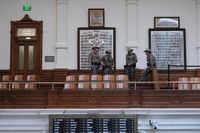In a dramatic standoff that has captured the nation’s attention, Texas Democrats returned to the state Capitol on August 18, 2025, after a two-week walkout aimed at blocking Republican-led redistricting efforts. Their homecoming was anything but triumphant: instead of resuming business as usual, the lawmakers found themselves under constant surveillance by state police, forced to sign “permission slips” for even the most basic movements. The spectacle, which some have called “performative theater” and others an outright abuse of power, has set the stage for a fierce partisan clash that now stretches from Austin to Sacramento, as California Democrats launch their own redistricting counteroffensive.
It all began on August 3, when over fifty Texas Democratic legislators fled the state—a move designed to deny Republicans the quorum needed to advance new congressional maps. These maps, critics argue, would favor Republicans and fulfill President Donald Trump’s request to shore up the GOP’s narrow House majority ahead of the 2026 midterms. According to Courthouse News, this walkout was the latest in a series of high-stakes maneuvers by both parties, with Democrats insisting the proposed districts would dilute minority voting power by slicing up diverse urban communities.
But when the Democrats returned, the Texas House was ready. Republican House Speaker Dustin Burrows announced that, “once quorum was restored, the call of the House would remain, and any member that was out because of the quorum break would be required to sign a permission slip agreeing to be under the authority of [the Texas Department of Public Safety] in order to leave the Capitol.” As reported by NPR’s Texas branch, the measure meant that lawmakers could not so much as leave for lunch or use the restroom without a police escort. Representative Mihaela Plesa described the experience as both surreal and invasive, noting that an officer “went with her for a staff lunch and even down the hallway with her for restroom breaks.”
For Democratic Representative Nicole Collier, the requirement was a bridge too far. Collier, who represents a majority-minority district in Fort Worth, refused to sign the permission slip and spent the night on the House floor. “I refuse to sign away my dignity as a duly elected representative just so Republicans can control my movements and monitor me with police escorts,” she declared in a statement quoted by Courthouse News. “My community is majority-minority, and they expect me to stand up for their representation.” Collier’s resistance quickly became symbolic of the broader Democratic protest, with supporters rallying outside the chamber and the House Democratic Caucus describing her as a “political prisoner.”
Collier did not merely lodge a protest—she took legal action, filing a habeas corpus petition in Travis County court. In her filing, she argued that the House’s sergeant-at-arms had no authority to detain her, given that she was present and not absent from the session. She also pointed out that no immediate quorum was required, making her continued confinement unnecessary and illegal. As of Monday evening, Collier remained on the House floor, determined to resist what she called “authoritarian tactics.”
Other Democrats, including Representatives Toni Rose and Gene Wu, reluctantly complied with the new rules, posing for photos with their permission slips. Rose called the surveillance “an unnecessary use of state resources,” while Representative Ann Johnson of Houston accused Governor Greg Abbott of “hijacking DPS to meet his political needs.” Johnson added, “I am not free, and my only crime is that I am an elected Democrat. That’s not okay. This is not normal. Nobody should treat this as normal.”
Meanwhile, the Republican leadership in Texas remained unapologetic. House Speaker Burrows insisted that the House would “withstand this” and that the rules of engagement were now clear. “Members, the House has been through a tumultuous two weeks, but this institution long predates us, and it will long outlast each of us,” he said, as reported by Courthouse News. Governor Abbott and Attorney General Ken Paxton, for their part, have petitioned the Texas Supreme Court to remove the Democratic lawmakers who fled the state, arguing that they abandoned their seats. The absent Democrats also face fines of $500 for each legislative day missed—a sum that reached $7,000 per member during the 14-day protest—and have been told they must cover law enforcement costs incurred during the walkout.
While the House did not conduct any legislative business on August 18 and was not scheduled to reconvene until August 20, the fight over redistricting is far from over. The House Select Committee on Redistricting advanced the new congressional maps along party lines, and the Senate’s committee quickly followed suit. If passed, the new districts could deliver five additional Republican seats in Congress, as requested by President Trump. Democrats, however, have vowed to challenge the maps in court, arguing that they are “grossly unconstitutional and discriminatory,” in the words of Representative Ann Johnson.
The standoff in Texas has not gone unnoticed elsewhere. On the very day the Texas Democrats returned, California Democrats introduced their own congressional maps, aiming to expand their party’s advantage by five seats. This move, described by ABC News as “retaliation,” is part of a broader tit-for-tat struggle between the nation’s two most populous states. California’s new proposal would target battleground districts and strengthen Democratic incumbents, with Governor Gavin Newsom calling for a November 4 special referendum to let voters decide whether to override the state’s independent redistricting commission.
The stakes could hardly be higher. Of the 435 seats in the U.S. House, only a few dozen are truly competitive, meaning that even small changes to district lines in a handful of states could tip the balance of power. With Democrats nationally just three seats away from a majority, and Republicans eager to cement their gains, the outcome of these redistricting battles will shape the political landscape for years to come.
As lawmakers in both Texas and California brace for legal challenges and further legislative maneuvers, one thing is clear: the battle over who draws the lines is about much more than maps. It’s a fight over the very rules of democracy, waged in courtrooms, capitols, and—at least for now—under the watchful eyes of state troopers.


